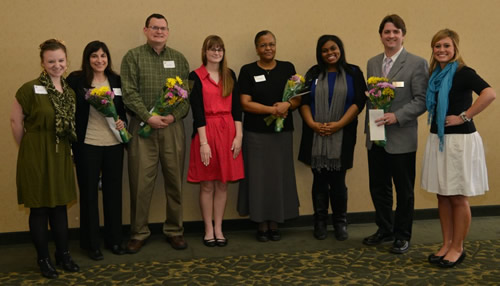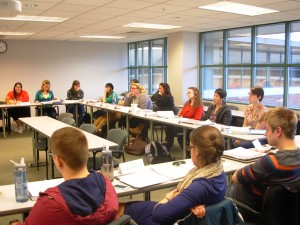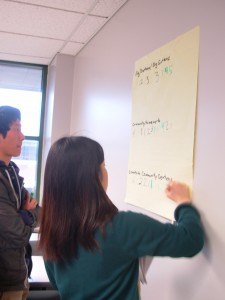Students Give More Than $14,000 to Local Nonprofits
On April 15, Western Michigan University’s School of Public Affairs and Administration (SPAA) held their yearly Nonprofit Banquet. Nearly 200 students, faculty, staff, and members of the community gathered as grant funding was presented to worthy nonprofit organizations in the Kalamazoo area. After months of research, site visits and deliberations, twenty-one WMU students selected four organizations to award more than $14,000 in grant funding. While giving is rewarding, deciding which organizations to award funding to was more challenging than anticipated.
The spring 2013 PADM 4000 Seminar in Nonprofit Leadership class knew what they were facing. They knew that by the end of the semester they would be able to give real financial support to organizations in need and were excited to use all of the skills they’d learned in their previous classes to review proposals and impact lives of Kalamazoo citizens. From the start, the class determined its priorities utilizing a consensus method. They wanted to support organizations with a focus on education and arts for children and help individuals and/or families get or sustain housing. The remainder of their decision-making stemmed from their established priorities while building upon their leadership readings and assignments.
Led by Janice Maatman, the class went through the tedious and sometimes emotionally charged process of reviewing grant proposals and financial statements in order to determine which organizations should receive the limited amount of funds that were available. Twenty-five organizations made requests totaling $117,000 and students grappled because they saw great potential in all of them. Even when trying to reduce the number of qualified organizations based on their established priorities, the class struggled with issues like the age group the organizations served and which programs would impact the most individuals.
Using a ranking system, the class narrowed down their list to six organizations based on criteria and prioritization established earlier in the semester. The deliberations that took place between the last six organizations resulted in visceral reactions. As a class, though, they showed maturity and understood the importance of building consensus throughout the process. Maatman stated, “After five years of teaching this class, this was the first year of no tears. This class had a good sense of when they needed to let go.” In order for the class to reach a consensus, all had to release a personal bias or initial favorite.
When asked what is the most influential part of teaching such a unique class, Maatman replied, “I’ve had these students in the intro class and in this seminar class. Seeing the growth, the maturity, the ability to use non-profit language and their internship experience as they do their analysis is rewarding.” Another benefit of leading students in a seminar is seeing the students’ “development in analysis, writing, and the ability to work with others critical to a career in non-profit management. They are able to give away real money and not deal in a hypothetical situation. It’s a culmination of their work.” Maatman said, “When they read the proposals it feel like an exercise, but after site visits it connects to real life and real people, especially if they can see programs in action. It becomes really motivating. Different things in different proposals resonate with individuals.”
Maatman’s impression of the class is shared by those directly influenced by her leadership. While attending a national education conference WMU recent graduate Kierstin Nall shared her experiences in PADM 4000 with students from institutions across the country and received the same response—students from other institutions were fascinated. Nall’s appreciation for the class stems from “diving into an organization’s records will help my life following graduation. I feel prepared to enter the working field. Consensus building is tough and challenging, but it is a vital life skill in the nonprofit leadership field.”
In addition to students who completed the most recent semester, former students were also a part of the Nonprofit Banquet. Elisse Rivert completed PADM 4000 during the spring semester of 2012 and remains appreciative of the lessons learned. Rivert states, “I had never heard of or been in a class like [PADM] 4000. It teaches prioritization and you learn what you believe in. Initially, we look at the numbers, but eventually, you are led by a desire to give to kids. You learn so much about yourself that you don’t intend to.” The impact was so great on Rivert that she recently applied for a job that would enable her to facilitate grant decision-making much like she did during her class experience for high school programs. Rivert went on to say, “A lot of kids can get through college. Not everyone can get this [Nonprofit Leadership Alliance] certificate and get life skills.”
This year’s seminar awarded grants to Big Brothers/Big Sisters, Community Homeworks, Crescendo Academy of Music, and the Irving S. Gilmore International Keyboard Festival. PADM 4000 could be one of the most impactful educational experiences in a nonprofit leadership student’s career at Western Michigan University. Having the opportunity to evaluate actual grant proposals, provide tangible resources to Kalamazoo organizations and follow-up with the organizations and individuals their decisions directly benefit, SPAA students are left with a permanent sense of accomplishment and a lesson in philanthropy that far exceeds their time at WMU.
WMU’s School of Public Affairs and Administration
Nonprofit Leadership Student Association





